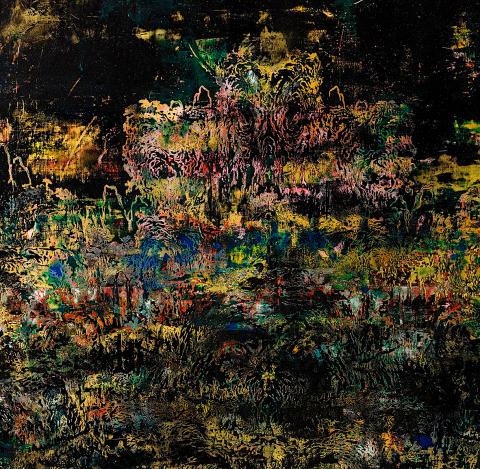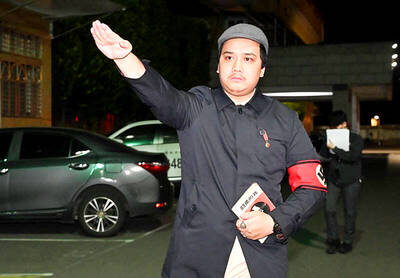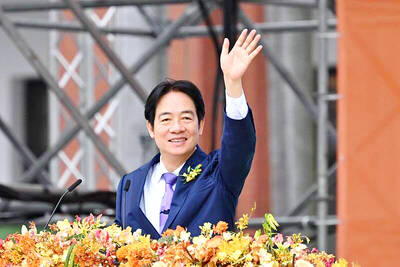Tina Keng Gallery (耿畫廊) presents Xiang Nai Er (香·奈·兒), a solo exhibition by Taiwanese artist Su Meng-hung (蘇孟鴻). Su creates paintings, silkscreen prints, installations and sculptures that often draw influences from Qing Dynasty paintings. The artist is particularly drawn to the popular genre of flowers and birds, a genre that reflects the aesthetic taste of the era’s aristocrats and literati. He takes these elements and transforms them into an original vocabulary of gaudy and grandiose icons, writes the gallery. Su’s present exhibition features a recent series of paintings that continue to explore similar visual themes while drawing inspiration from Coco Chanel’s collection of Chinese ebony screens. The screens consist of a collage of pearl shells in the shape of Chinese flowers and birds inlaid in antique lacquered ebony and placed against a resplendent landscape of ivory, jade, enamel, gold and silver. Chanel is known for taking these cultural symbols and incorporating them into elegant embroidered fabric patterns. Su is interested in Chanel’s appropriation of Chinese classics and the Western interpretation of China in mass culture.
■ Tina Keng Gallery (耿畫廊), 15, Ln 548, Ruiguang Rd, Taipei City (台北市瑞光路548巷15號), tel: (02) 2659-0798. Open Tuesdays to Sundays from 10am to 7pm
■ Until July 7

Photo courtesy of S7 Art Museum
Idas Losin is a New Taipei City-based artist of Truku and Atayal descent. She expresses her concerns and appreciation for her people, gender and environment through refined oil paintings characterized by fine brushwork, contrasting colors and flattened perspectives. She often integrates textile patterns and tattoos into portraiture and landscapes, thereby marking her images with the visual language of the Pacific. In 2013 Losin began a journey of island hopping across the Austronesian region in order to experience, study and learn from the diverse cultures that have developed from the same roots. She has traveled through Easter Island, Hawaii, Guam, New Zealand, Tahiti, Taiwan and Orchid Island. On every island, Losin would tattoo herself with indigenous patterns, as if piecing together a network of identities on her body. Her solo exhibition, Island Hopping, Fantasy and Milky Way (跳島 幻島 天河), currently on view at XUE XUE White Gallery (學學白色展覽空間), features 43 works created in the last 15 years. These works include island landscapes and images that record her observations of Pacific cultures, as well as express concerns of land justice and environmental issues. Her most recent works depict the conditions of human survival in today’s state of global warming.
■ XUE XUE White Gallery (學學白色展覽空間), 7F, 207, Tiding Boulevard Sec 2, Taipei City (台北市堤頂大道二段 207號7樓), tel: (02) 8751-6898 ext 321, Open daily from 11am to 5pm
■ Until July 28

Photo Courtesy of Mind Set Art Center
The Museum of Contemporary Art, Taipei (台北當代藝術館) presents Rooftop (天台), a solo show by Taipei-based Chu Chun-teng (朱駿騰). With a background in film studies, the artist produces installations and videos that respond to the dilemmas individuals face in modern society. Last year, Chu was invited to participate in an artist residency in Tengchong (騰衝), a city situated along the border of China and Burma, known for its rich natural resources and production of jade. The artist’s work examines the impact of the jade factories and shops and the cultural significance of the precious stone and its relation to the desires of the people. One of the most memorable encounters for Chu was the digging for jade on sites where old buildings have been torn down for urban renewal. Thousands of locals would dig holes at the newly leveled sites hoping to find jade buried from centuries ago — “as if all their future hopes relied on this never-ending action,” writes the artist in the exhibition preface.
■ Museum of Contemporary Art (台北當代藝術館, MOCA, Taipei), 39, Changan W Rd, Taipei City (台北市長安西路39號), tel: (02) 2559-6615. Open Tuesdays to Sundays from 10am to 6pm
■ Until July 28

Photo Courtesy of Tina Keng Gallery
Finding Myself in Time (不負光陰) is a group exhibition of four artists currently in residence at Taipei Art Village. The curatorial text draws from Japanese novelist Haruki Murakami’s South of the Border, West of the Sun, in which he writes: “There are some things in this world that can be done over, and some that can’t. And time passing is one thing that can’t be redone.” The quote encapsulates a reflection on life, the passing of time and the process of fulfillment. Korean artist Yung Yoo-seung creates multimedia works about women and the LGBT community. The presentation of texts, photos and objects juxtaposes her experiences of gender awareness events in Korea and Taiwan and the dynamics of the groups she has witnessed. Federic Delfrati is a Munich-based Italian artist who defines the role of the artist as a lone satellite that observes alien societies in parallel or disjointed orbits. He is interested Taiwan’s Karaoke culture and the relationship between the architecture of karaoke rooms and the social status and boundaries they spatially signify. Taiwanese artist Chang Nai-jen (張乃仁) presents an installation based on his memories of his family. Central to his project lies his uncle’s Camellia and the artist’s interpretation of his uncle’s pursuit of beauty. Hsu Yen-ting (許雁婷) is a Taipei-based sound artist who over the course of her residency revisits her childhood neighborhood in Taipei’s Xincheng Street (興城街). Working with sounds recorded from local blacksmith shops, she attempts to piece together her memories of the once bustling industry.
■ Barry Room, Taipei Artist Village (台北國際藝術村百里廳), 7 Beiping E Rd, Taipei City (台北市北平東路7號), tel: (02) 3393-7377. Open Tuesdays to Sundays from 11am to 9pm
■ Until June 23

Photo Courtesy of Xue Xue White Gallery
Mark Nilsson is an artist based in New York and Pingtung who has recently completed a residency at Chishang Art Village (池上藝術村) in Taitung. As a painter, Nilsson creates portraits and landscapes that are heavily loaded with acrylic paint, which he rapidly applies with sweeping or stabbing gestures. While painting, Nilsson keeps his body in constant motion with tasks of preparing, adding and moving the paint around his palette and work surface. “By the end of a painting, my clothes, my palette, my hands and arms and the ground around me will all be a complete mess,” writes the artist. His solo exhibition, Gestures (手擺腳動), at S7 Art Museum, features recent works completed in Pingtung and Taitung. The Chinese title of the show refers to an idiom that describes searching for understanding in a foreign language. This figurative striving for communication resonates with Nilsson’s painting practice, which extends beyond the picture frame.
■ S7 Art Museum (S7美術館), 286, Chengde Street, Taipei City (台北市承德路七段286號), tel: (02) 2821-1599. Open Tuesday to Sunday from 11am to 6:30pm
■ Until July 31

May 18 to May 24 Pastor Yang Hsu’s (楊煦) congregation was shocked upon seeing the land he chose to build his orphanage. It was surrounded by mountains on three sides, and the only way to access it was to cross a river by foot. The soil was poor due to runoff, and large rocks strewn across the plot prevented much from growing. In addition, there was no running water or electricity. But it was all Yang could afford. He and his Indigenous Atayal wife Lin Feng-ying (林鳳英) had already been caring for 24 orphans in their home, and they were in

On May 2, Chinese Nationalist Party (KMT) Chairman Eric Chu (朱立倫), at a meeting in support of Taipei city councilors at party headquarters, compared President William Lai (賴清德) to Hitler. Chu claimed that unlike any other democracy worldwide in history, no other leader was rooting out opposing parties like Lai and the Democratic Progressive Party (DPP). That his statements are wildly inaccurate was not the point. It was a rallying cry, not a history lesson. This was intentional to provoke the international diplomatic community into a response, which was promptly provided. Both the German and Israeli offices issued statements on Facebook

Even by the standards of Ukraine’s International Legion, which comprises volunteers from over 55 countries, Han has an unusual backstory. Born in Taichung, he grew up in Costa Rica — then one of Taiwan’s diplomatic allies — where a relative worked for the embassy. After attending an American international high school in San Jose, Costa Rica’s capital, Han — who prefers to use only his given name for OPSEC (operations security) reasons — moved to the US in his teens. He attended Penn State University before returning to Taiwan to work in the semiconductor industry in Kaohsiung, where he

President William Lai (賴清德) yesterday delivered an address marking the first anniversary of his presidency. In the speech, Lai affirmed Taiwan’s global role in technology, trade and security. He announced economic and national security initiatives, and emphasized democratic values and cross-party cooperation. The following is the full text of his speech: Yesterday, outside of Beida Elementary School in New Taipei City’s Sanxia District (三峽), there was a major traffic accident that, sadly, claimed several lives and resulted in multiple injuries. The Executive Yuan immediately formed a task force, and last night I personally visited the victims in hospital. Central government agencies and the